Search Result
Results for "
Gly-Gly-Arg
" in MedChemExpress (MCE) Product Catalog:
| Cat. No. |
Product Name |
Target |
Research Areas |
Chemical Structure |
-
- HY-P0019A
-
|
|
Fluorescent Dye
|
Others
|
|
Z-Gly-Gly-Arg-AMC acetate is a thrombin-specific fluorogenic substrate for testing of thrombin generation in PRP and platelet-poor plasma (PPP).
|
-
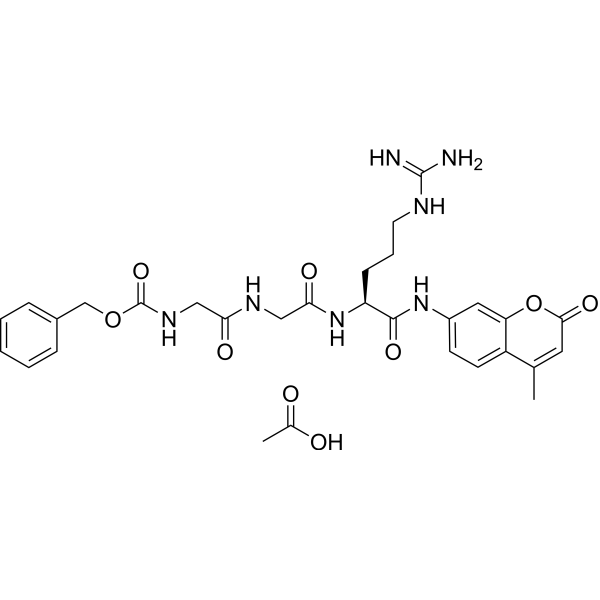
-
- HY-P0019B
-
|
|
Fluorescent Dye
|
Others
|
|
Z-Gly-Gly-Arg-AMC TFA is the TFA salt form of Z-Gly-Gly-Arg-AMC (HY-P0019). Z-Gly-Gly-Arg-AMC TFA is a thrombin-specific fluorogenic substrate for testing of thrombin generation in PRP and platelet-poor plasma (PPP) .
|
-

-
- HY-P0019
-
-
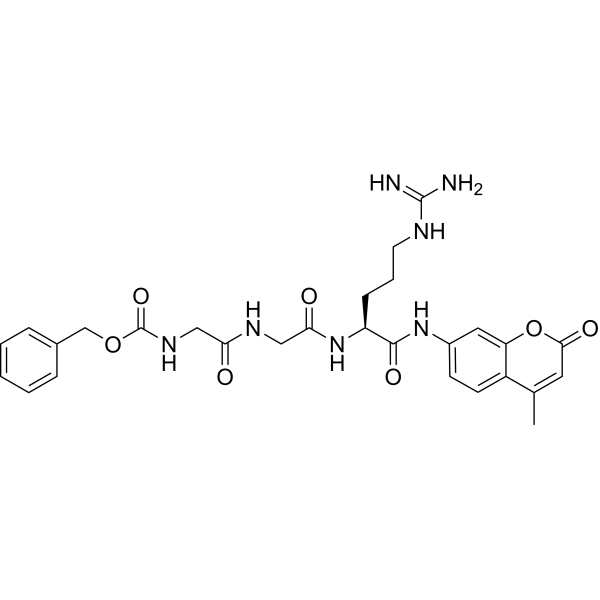
-
- HY-P5711
-
-

-
- HY-P5617
-
|
|
Bacterial
|
Others
|
|
Cathepsin G(1-5) is an antimicrobial peptide that can be found in the clostripain-digested cathepsin G mixture .
|
-
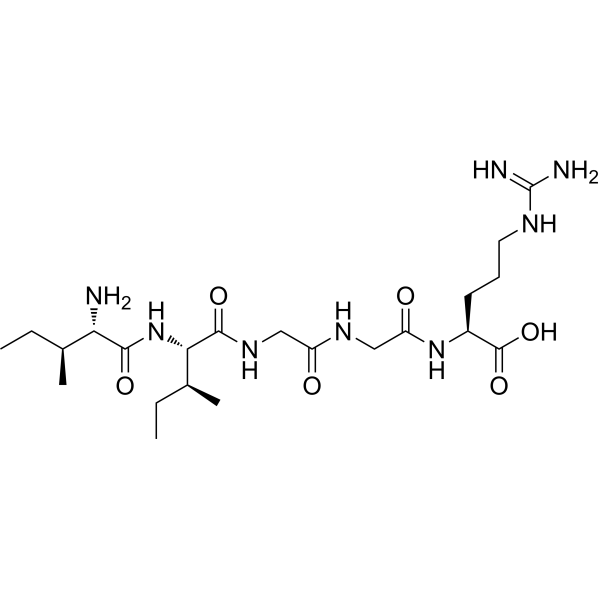
-
- HY-P0284
-
|
|
MMP
|
Inflammation/Immunology
|
|
C-telopeptide, a cross-linked peptide of type I collagen, is released during bone resorption and has been correlated with bone mineral density (BMD).
|
-
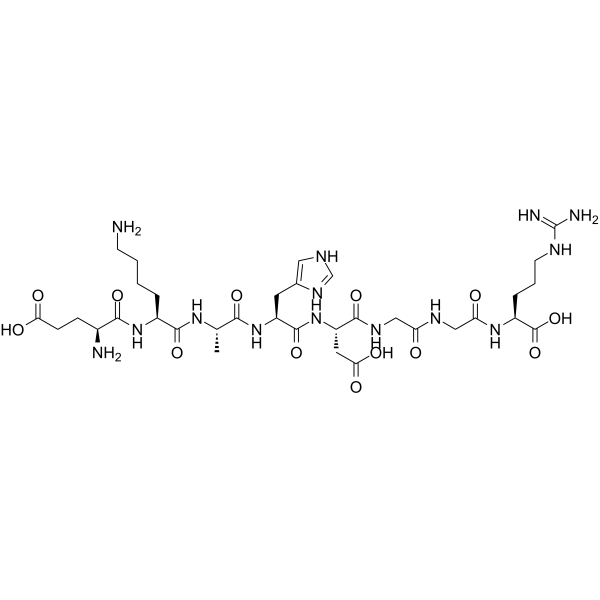
-
- HY-P2456
-
|
|
p38 MAPK
|
Others
|
|
MBP MAPK Substrate is used as an exogenous substrate for MAPK .
|
-
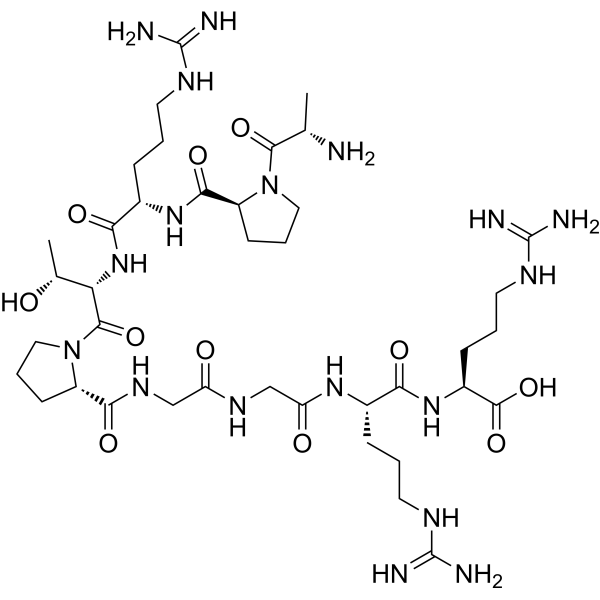
-
- HY-P3828
-
|
|
Fluorescent Dye
|
Neurological Disease
|
|
Biotin-myelin basic protein (94-102) is a peptide fragemt. Myelin basic protein is responsible for adhesion of the cytosolic surfaces of multilayered compact myelin, it plays an important role in the process of myelination of nerves in the nervous system. Myelin basic protein also acts as a membrane actin-binding protein, which might allow it to participate in transmission of extracellular signals to the cytoskeleton in oligodendrocytes and tight junctions in myelin .
|
-
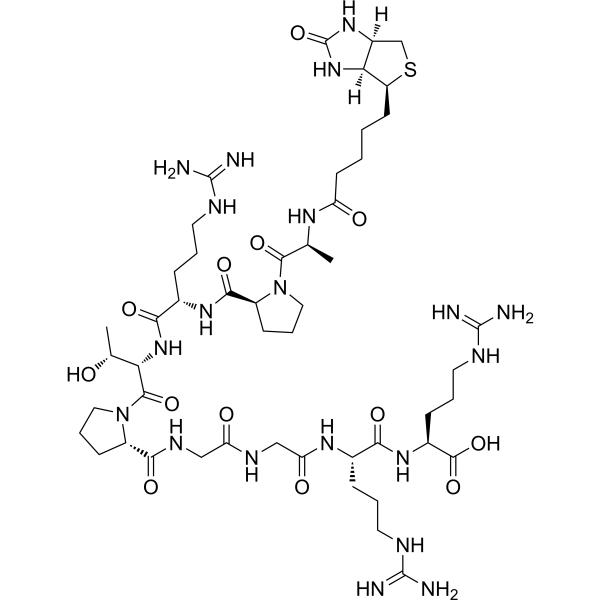
-
- HY-P5107
-
|
|
VEGFR
|
Cancer
|
|
Protein LMWP is a cell-penetrating peptide with vascular endothelial growth factor (VEGF) inhibitory activity. Protein LMWP can inhibit tumor growth and is used in cancer research .
|
-
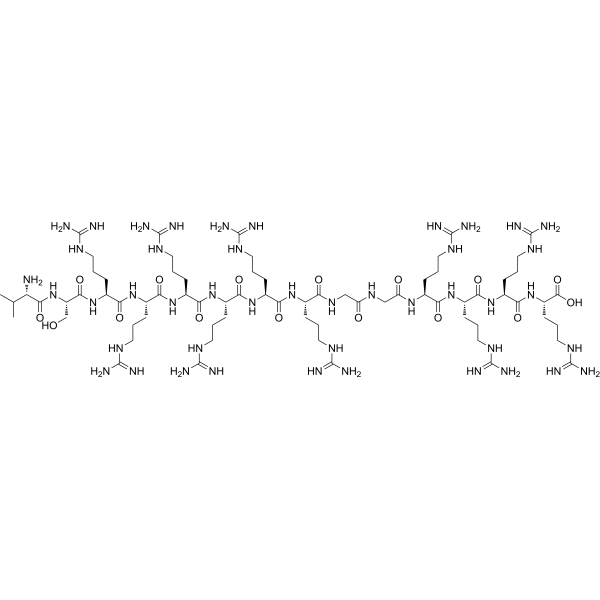
-
- HY-P3586
-
|
Hunter-killer peptide ao; Prohibitin-tArgeting peptide 1; prohibitin-TP01; Adipotide
|
Apoptosis
|
Cancer
|
|
HKPao (Hunter-killer peptide ao) is a biologically active peptide. HKPao (Hunter-killer peptide ao) has anti-obesity and anti-tumor pro-apoptotic activity to cause release of cytochrome c from vesicles .
|
-
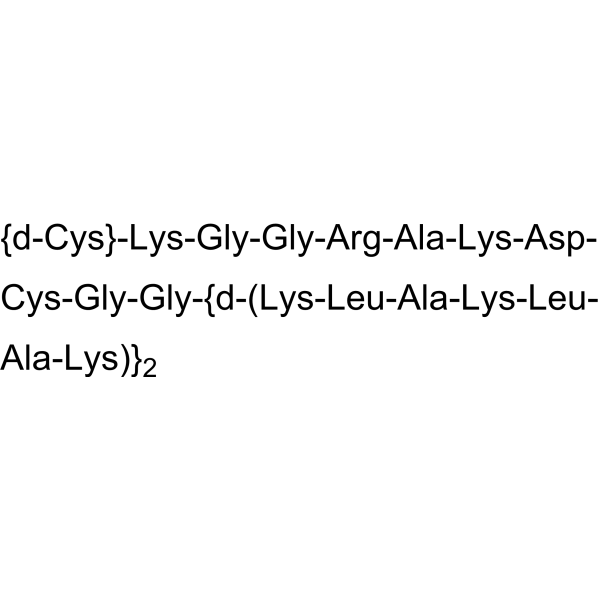
-
- HY-P5891
-
|
|
PKC
|
Cardiovascular Disease
|
|
TAT-SAMβA is the peptide consist of RNAENFDRF (SAMβA; HY-P3429) conjugated to the cell penetrating TAT protein-derived peptide TAT47–57. TAT-SAMβA is a selective antagonist of Mfn1-βIIPKC association. TAT-SAMβA protects mouse embryonic fibroblast cells (MEFs) against oxidative stress-induced cytotoxicity .
|
-

-
- HY-P1912
-
|
|
MMP
|
Endocrinology
|
|
Alpha 1(I) Collagen (614-639), human is a peptide fragment of alpha-1 type I collagen.
|
-

-
- HY-P2281
-
-

-
- HY-P10167
-
|
|
Phosphatase
|
Others
|
|
11R-CaN-AID is a potent and cell permeant inhibitor of calcineurin .
|
-

-
- HY-P5552
-
|
|
Bacterial
Parasite
Fungal
|
Infection
|
|
Melimine is a hybrid antimicrobial peptide of Melittin (HY-P0233) and Protamine. Melimine is active against P. aeruginosa and S. aureus. Melimine has broad spectrum activity against bacteria, fungi and protozoa .
|
-

-
- HY-P5792
-
|
ANP (3-28) (human)
|
Endothelin Receptor
|
Metabolic Disease
|
|
Atrial natriuretic peptide (3-28) (human) (ANP (3-28) (human)) is a peptide hormone that is synthesized and secreted by the atrial myocardium. Atrial natriuretic peptide (3-28) (human) is involved in the regulation of blood pressure, fluid balance, and electrolyte homeostasis .
|
-

-
- HY-P1235
-
|
Atrial Natriuretic Peptide (ANP) (1-28), human, porcine
|
Endothelin Receptor
|
Cardiovascular Disease
Endocrinology
|
|
Carperitide (Atrial Natriuretic Peptide (ANP) (1-28), human, porcine) is a 28-amino acid hormone, that is normally produced and secreted by the human heart in response to cardiac injury and mechanical stretch. Carperitide (Atrial Natriuretic Peptide (ANP) (1-28), human, porcine) inhibits endothelin-1 secretion in a dose-dependent way.
|
-
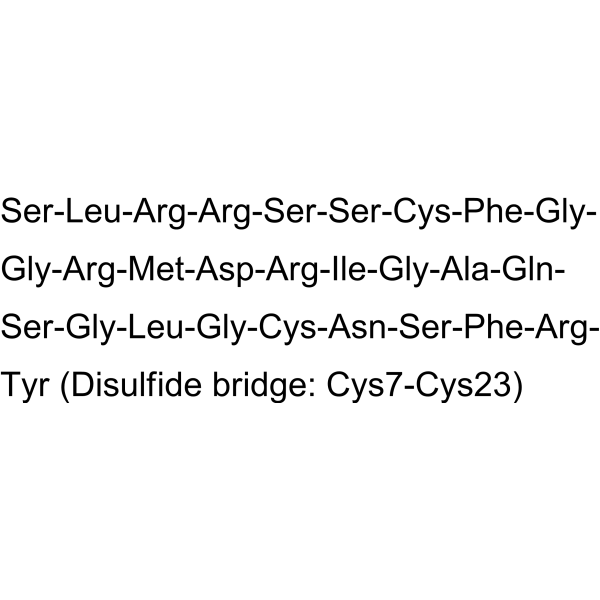
-
- HY-P1236
-
|
Atrial natriuretic factor (1-28) (rat)
|
Endothelin Receptor
|
Cardiovascular Disease
Endocrinology
|
|
Atrial Natriuretic Peptide (ANP) (1-28), rat is a major circulating form of ANP in rats, potently inhibits Angiotensin II (Ang II)-stimulated endothelin-1 secretion in a concentration-dependent manner.
|
-

-
- HY-P1235A
-
|
Atrial Natriuretic Peptide (ANP) (1-28), human, porcine acetate
|
Endothelin Receptor
|
Cardiovascular Disease
Endocrinology
|
|
Carperitide acetate (Atrial Natriuretic Peptide (ANP) (1-28), human, porcine acetate) is a 28-amino acid hormone, that is normally produced and secreted by the human heart in response to cardiac injury and mechanical stretch. Carperitide acetate inhibits endothelin-1 secretion in a dose-dependent way.
|
-
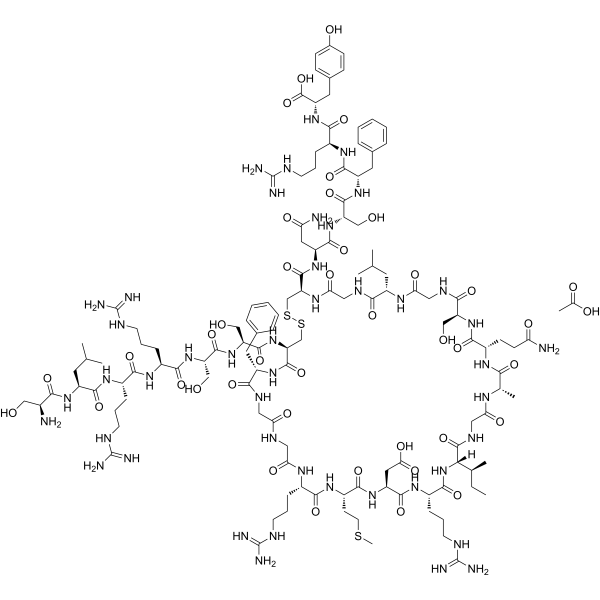
-
- HY-P1236A
-
|
Atrial natriuretic factor (1-28) (rat) TFA
|
Endothelin Receptor
|
Cardiovascular Disease
Endocrinology
|
|
Atrial Natriuretic Peptide (ANP) (1-28), rat (TFA) is a major circulating form of ANP in rats, potently inhibits Angiotensin II (Ang II)-stimulated endothelin-1 secretion in a concentration-dependent manner.
|
-

-
- HY-P2491
-
|
|
Fluorescent Dye
|
Cardiovascular Disease
Endocrinology
|
|
Atrial Natriuretic Peptide (1-28), human, porcine, Biotin-labeled, one of three mammalian natriuretic peptides (NPs), has endocrine effects on fluid homeostasis and blood pressure. Atrial Natriuretic Peptide has the potential for cardiovascular diseases research .
|
-

-
- HY-P10238
-
|
|
Apoptosis
|
Cancer
|
|
MYBMIM is an inhibitor for assembly of the molecular MYB:CBP/P300 complex. MYBMIM inhibits growth of leukemia cells .
|
-

-
- HY-P1064A
-
|
|
HIV
Apelin Receptor (APJ)
|
Infection
Cardiovascular Disease
Metabolic Disease
|
|
Apelin-36(human) TFA is an endogenous orphan G protein-coupled receptor APJ agonist, with an EC50 of 20 nM. Apelin-36(human) TFA shows high affinity to human APJ receptors expressed in HEK 293 cells (pIC550=8.61). Apelin-36(human) TFA has been linked to two major types of biological activities: cardiovascular and metabolic. Apelin-36(human) TFA inhibits the entry of some HIV-1 and HIV-2 into the NP2/CD4 cells expressing APJ .
|
-

-
- HY-P1065A
-
|
|
HIV
Apelin Receptor (APJ)
|
Infection
Cardiovascular Disease
Metabolic Disease
|
|
Apelin-36(rat, mouse) TFA is an endogenous orphan G protein-coupled receptor APJ agonist. Apelin-36(rat, mouse) TFA binds to APJ receptors with an IC50 of 5.4 nM, and potently inhibits cAMP production with an EC50 of 0.52 nM. Apelin-36(rat, mouse) TFA blocks entry of some HIV-1 and HIV-2 strains into NP-2/CD4 cells expressing APJ .
|
-

-
- HY-P1064
-
|
|
Apelin Receptor (APJ)
HIV
|
Infection
Cardiovascular Disease
Metabolic Disease
|
|
Apelin-36(human) is an endogenous orphan G protein-coupled receptor APJ agonist, with an EC50 of 20 nM. Apelin-36(human) shows high affinity to human APJ receptors expressed in HEK 293 cells (pIC50=8.61). Apelin-36 has been linked to two major types of biological activities: cardiovascular and metabolic. Apelin-36(human) inhibits the entry of some HIV-1 and HIV-2 into the NP2/CD4 cells expressing APJ .
|
-
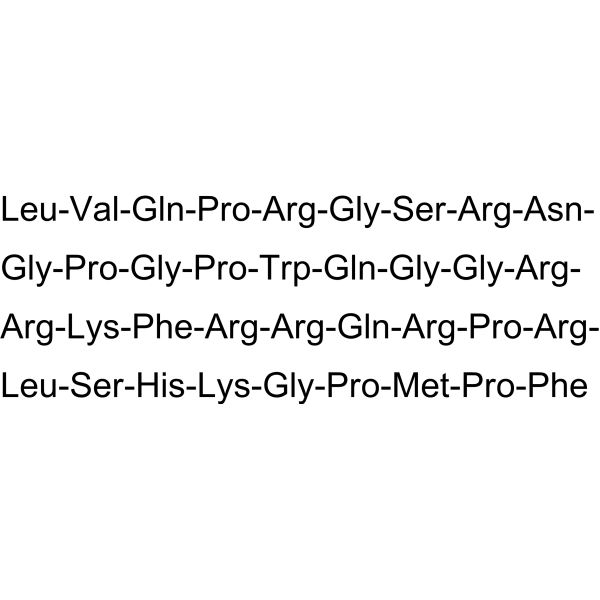
-
- HY-P4086
-
|
|
RABV
|
Infection
|
|
Chimeric Rabies Virus Glycoprotein Fragment (RVG-9R), a chimeric peptide consisting of 29 amino acids, is synthesized by adding nona-arginine motif to the carboxy terminus of RVG (rabies virus glycoprotein). Chimeric Rabies Virus Glycoprotein Fragment (RVG-9R) is positively charged and able to bind negatively charged nucleic acids via charge interaction .
|
-

-
- HY-P2312
-
|
HβD-3
|
Antibiotic
Bacterial
|
Infection
|
|
Human β-defensin-3 (HβD-3) is an antibiotic anti-microbial peptide produced by epithelial cells with antimicrobial activities and reduces the effect of inflammatory cytokine responses. Human β-defensin-3 is against different microbes with IC90 values of 6-25 μg/ml .
|
-
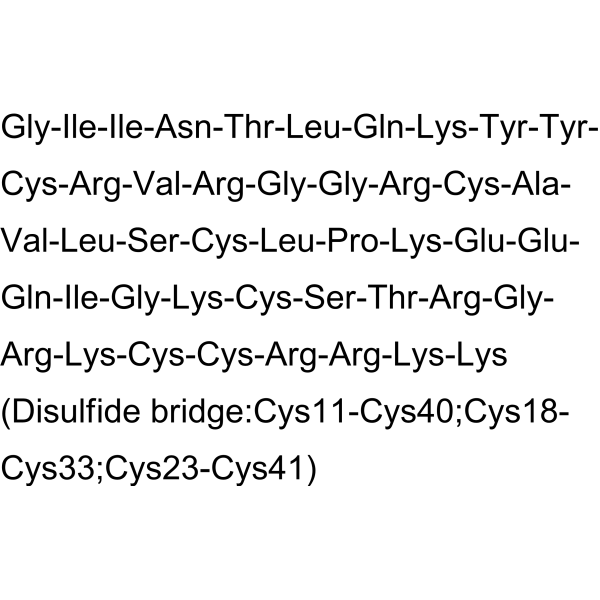
-
- HY-P3012
-
|
|
Cathepsin
|
Inflammation/Immunology
|
|
Cathepsin G acts as a potent agonist of human platelet activation leading to their aggregation., and can be used for screening of relevant inhibitors .
|
-

| Cat. No. |
Product Name |
Type |
-
- HY-P0019A
-
|
|
Chromogenic Substrates
|
|
Z-Gly-Gly-Arg-AMC acetate is a thrombin-specific fluorogenic substrate for testing of thrombin generation in PRP and platelet-poor plasma (PPP).
|
-
- HY-P0019
-
|
|
Chromogenic Substrates
|
|
Z-Gly-Gly-Arg-AMC is a thrombin-specific fluorogenic substrate for testing of thrombin generation in PRP and platelet-poor plasma (PPP).
|
| Cat. No. |
Product Name |
Target |
Research Area |
-
- HY-P0019A
-
|
|
Fluorescent Dye
|
Others
|
|
Z-Gly-Gly-Arg-AMC acetate is a thrombin-specific fluorogenic substrate for testing of thrombin generation in PRP and platelet-poor plasma (PPP).
|
-
- HY-P4249
-
|
|
Peptides
|
Endocrinology
|
|
Gly-Gly-Arg is a tripeptide, and a “pumping pheromone” released from the hatching eggs. Gly-Gly-Arg induces pleopod pumping activity, with the threshold concentration of 10 nM. Gly-Gly-Arg shows maximum percentage response of 58.3%. Gly-Gly-Arg act as pheromones and controlls larval release in subtidal crustaceans .
|
-
- HY-P5355
-
|
|
Peptides
|
Others
|
|
Z-Gly-Gly-Arg-AFC is a biological active peptide. (Plasminogen Activator Acrosine Substrate, fluorescent Z-Gly-Gly-Arg-AFC)
|
-
- HY-P5202
-
|
|
Peptides
|
Others
|
|
H-Gly-Gly-Arg-AMC is a fluorogenic peptidyl-AMC substrate containing C-terminal 7-amino-4-methylcoumarin (AMC). H-Gly-Gly-Arg-AMC is a suitable for monitoring continuous thrombin generation (TGT) .
|
-
- HY-P4514
-
|
|
Peptides
|
Others
|
|
Z-Gly-Gly-Arg-βNA is the synthetic peptide substrate of trypsin-like activities of the proteasome .
|
-
- HY-P0019B
-
|
|
Fluorescent Dye
|
Others
|
|
Z-Gly-Gly-Arg-AMC TFA is the TFA salt form of Z-Gly-Gly-Arg-AMC (HY-P0019). Z-Gly-Gly-Arg-AMC TFA is a thrombin-specific fluorogenic substrate for testing of thrombin generation in PRP and platelet-poor plasma (PPP) .
|
-
- HY-P0019
-
-
- HY-P4267
-
|
|
Peptides
|
Others
|
|
H-Gly-Gly-Arg-Ser-Pro-Ala-Met-Pro-Glu-OH is a polypeptide that can be found by peptide screening. Peptide screening is a research tool that pools active peptides primarily by immunoassay. Peptide screening can be used for protein interaction, functional analysis, epitope screening, especially in the field of agent research and development .
|
-
- HY-P5711
-
-
- HY-P5617
-
|
|
Bacterial
|
Others
|
|
Cathepsin G(1-5) is an antimicrobial peptide that can be found in the clostripain-digested cathepsin G mixture .
|
-
- HY-P2219
-
|
|
Peptides
|
Cancer
|
|
CGGRGD, a RGD derivative with cysteine as its N-terminal, CGGRGD is synthesized via solid-phase peptide synthesis technique and the surface of PCL fibers is aminolysised by amino 2-cyanobenzothiazole followed by the addition of 2-cyanobenzothiazole (CBT) .
|
-
- HY-P2219A
-
|
|
Peptides
|
Cancer
|
|
CGGRGD TFA, a RGD derivative with cysteine as its N-terminal, CGGRGD TFA is synthesized via solid-phase peptide synthesis technique and the surface of PCL fibers is aminolysised by amino 2-cyanobenzothiazole followed by the addition of 2-cyanobenzothiazole (CBT) .
|
-
- HY-P0284
-
|
|
MMP
|
Inflammation/Immunology
|
|
C-telopeptide, a cross-linked peptide of type I collagen, is released during bone resorption and has been correlated with bone mineral density (BMD).
|
-
- HY-P2456
-
|
|
p38 MAPK
|
Others
|
|
MBP MAPK Substrate is used as an exogenous substrate for MAPK .
|
-
- HY-P6022
-
|
|
Peptides
|
Others
|
|
G4RGDSP, Integrin-binding peptide is a cell integrin-binding peptide that targets integrin receptors. G4RGDSP, integrin-binding peptide is coupled to alginate to increase the viability of cells in the scaffold. G4RGDSP, integrin-binding peptide can be used as an extrudable carrier for chondrocyte delivery for the study of 3D printing technology
|
-
- HY-P3828
-
|
|
Fluorescent Dye
|
Neurological Disease
|
|
Biotin-myelin basic protein (94-102) is a peptide fragemt. Myelin basic protein is responsible for adhesion of the cytosolic surfaces of multilayered compact myelin, it plays an important role in the process of myelination of nerves in the nervous system. Myelin basic protein also acts as a membrane actin-binding protein, which might allow it to participate in transmission of extracellular signals to the cytoskeleton in oligodendrocytes and tight junctions in myelin .
|
-
- HY-P5257
-
|
CG-EDP3
|
Peptides
|
Others
|
|
Oligopeptide-24 (CG-EDP3) s a bioactive peptide with skin repair effect and has been reported used as a cosmetic ingredient .
|
-
- HY-P5107
-
|
|
VEGFR
|
Cancer
|
|
Protein LMWP is a cell-penetrating peptide with vascular endothelial growth factor (VEGF) inhibitory activity. Protein LMWP can inhibit tumor growth and is used in cancer research .
|
-
- HY-P2026
-
|
|
Peptides
|
Cardiovascular Disease
|
|
A 71915 is a highly potent and competitive natriuretic peptide receptor A (ANP, NPRA) antagonist (pKi= 9.18). A 71915 displaces [ 125I]ANP dose dependently, with a Ki of 0.65 nM. A71915( pA2= 9.48) against rat ANP-induced cGMP production in NB-OK-1 cells .
|
-
- HY-P4098
-
|
|
Peptides
|
Others
|
|
SynB1 is a cell penetrating polypeptide, internalized by, or is associated with lipid vesicle (LV). SynB1 can be used to lipid vesicle-mediated delivery to cells .
|
-
- HY-P3586
-
|
Hunter-killer peptide ao; Prohibitin-tArgeting peptide 1; prohibitin-TP01; Adipotide
|
Apoptosis
|
Cancer
|
|
HKPao (Hunter-killer peptide ao) is a biologically active peptide. HKPao (Hunter-killer peptide ao) has anti-obesity and anti-tumor pro-apoptotic activity to cause release of cytochrome c from vesicles .
|
-
- HY-P5891
-
|
|
PKC
|
Cardiovascular Disease
|
|
TAT-SAMβA is the peptide consist of RNAENFDRF (SAMβA; HY-P3429) conjugated to the cell penetrating TAT protein-derived peptide TAT47–57. TAT-SAMβA is a selective antagonist of Mfn1-βIIPKC association. TAT-SAMβA protects mouse embryonic fibroblast cells (MEFs) against oxidative stress-induced cytotoxicity .
|
-
- HY-P1633
-
|
PG1
|
Peptides
|
Others
|
|
Protegrin-1 is a antimicrobial peptide with antimicrobial activity
|
-
- HY-P2269
-
|
|
Peptides
|
Cancer
|
|
MAIT-203, a cyclopentyalanin-derived peptidomimetic, potently inhibits the interaction of adenomatous polyposis coli (APC) and Asef (RhoGEF4), but not APC-Sam68 or APC-striatin interactions. MAIT-203 binds APC-ARM with a Ki of 0.015 μM and a Kd of 0.036 μM. MAIT-203 significantly represses the migration and invasion of colorectal cancer cells.
|
-
- HY-P10248
-
|
|
Peptides
|
Endocrinology
|
|
Atriopeptin I rat, mouse is an atrial natriuretic peptide, which stimulates the testosterone production with half-maximum stimulation of 38 nM .
|
-
- HY-P1912
-
|
|
MMP
|
Endocrinology
|
|
Alpha 1(I) Collagen (614-639), human is a peptide fragment of alpha-1 type I collagen.
|
-
- HY-P10279
-
|
Human atrial natriuretic factor (102–126)
|
Peptides
|
Cardiovascular Disease
Others
|
|
Anaritide is a synthetic form of atrial natriuretic peptide (ANP) composed of 25 amino acids. Anaritide increases glomerular filtration rate by dilating into and contracting out the bulbar arterioles. Anaritide can be used to study the effects on patients with acute tubular necrosis, particularly in improving dialysis free survival .
|
-
- HY-P4906
-
|
|
Peptides
|
Others
|
|
Atrial Natriuretic Factor (5-27) (human) is a polypeptide that can be found by peptide screening. Peptide screening is a research tool that pools active peptides primarily by immunoassay. Peptide screening can be used for protein interaction, functional analysis, epitope screening, especially in the field of agent research and development .
|
-
- HY-P5978
-
|
ANP 127-150 (rat)
|
Peptides
|
Cardiovascular Disease
|
|
Atriopeptin III (ANP 127-150) (rat), a 24-amino acid atrial peptide, is a potent vasodilator and natriuretic/diuretic agent. Atriopeptin III (rat) improves renal functions and decreases blood pressure in a ureter-obstructed rat kidney model. Atriopeptin III (rat) can be used for research of chronic renal failure .
|
-
- HY-P3060
-
|
|
Peptides
|
Cardiovascular Disease
|
|
Atriopeptin II rat, mouse is an atrial natriuretic peptide, which acts as diuretic and natriuretic agent, and a potent relaxant of vascular smooth muscle .
|
-
- HY-P2281
-
-
- HY-P10167
-
|
|
Phosphatase
|
Others
|
|
11R-CaN-AID is a potent and cell permeant inhibitor of calcineurin .
|
-
- HY-P10168
-
|
|
Peptides
|
Others
|
|
11R-CaN-CON is a control inactive peptide and can be used as a negative control for 11R-CaN-AID (HY-P10167) .
|
-
- HY-P5552
-
|
|
Bacterial
Parasite
Fungal
|
Infection
|
|
Melimine is a hybrid antimicrobial peptide of Melittin (HY-P0233) and Protamine. Melimine is active against P. aeruginosa and S. aureus. Melimine has broad spectrum activity against bacteria, fungi and protozoa .
|
-
- HY-P5792
-
|
ANP (3-28) (human)
|
Endothelin Receptor
|
Metabolic Disease
|
|
Atrial natriuretic peptide (3-28) (human) (ANP (3-28) (human)) is a peptide hormone that is synthesized and secreted by the atrial myocardium. Atrial natriuretic peptide (3-28) (human) is involved in the regulation of blood pressure, fluid balance, and electrolyte homeostasis .
|
-
- HY-P1235
-
|
Atrial Natriuretic Peptide (ANP) (1-28), human, porcine
|
Endothelin Receptor
|
Cardiovascular Disease
Endocrinology
|
|
Carperitide (Atrial Natriuretic Peptide (ANP) (1-28), human, porcine) is a 28-amino acid hormone, that is normally produced and secreted by the human heart in response to cardiac injury and mechanical stretch. Carperitide (Atrial Natriuretic Peptide (ANP) (1-28), human, porcine) inhibits endothelin-1 secretion in a dose-dependent way.
|
-
- HY-P1236
-
|
Atrial natriuretic factor (1-28) (rat)
|
Endothelin Receptor
|
Cardiovascular Disease
Endocrinology
|
|
Atrial Natriuretic Peptide (ANP) (1-28), rat is a major circulating form of ANP in rats, potently inhibits Angiotensin II (Ang II)-stimulated endothelin-1 secretion in a concentration-dependent manner.
|
-
- HY-P1235A
-
|
Atrial Natriuretic Peptide (ANP) (1-28), human, porcine acetate
|
Endothelin Receptor
|
Cardiovascular Disease
Endocrinology
|
|
Carperitide acetate (Atrial Natriuretic Peptide (ANP) (1-28), human, porcine acetate) is a 28-amino acid hormone, that is normally produced and secreted by the human heart in response to cardiac injury and mechanical stretch. Carperitide acetate inhibits endothelin-1 secretion in a dose-dependent way.
|
-
- HY-P1236A
-
|
Atrial natriuretic factor (1-28) (rat) TFA
|
Endothelin Receptor
|
Cardiovascular Disease
Endocrinology
|
|
Atrial Natriuretic Peptide (ANP) (1-28), rat (TFA) is a major circulating form of ANP in rats, potently inhibits Angiotensin II (Ang II)-stimulated endothelin-1 secretion in a concentration-dependent manner.
|
-
- HY-120521
-
|
|
Peptides
|
Neurological Disease
|
|
Urodilatin is an analogue of ANF-(99-126). Urodilatin is a diuretic-natriuretic regulatory peptide. Urodilatin can be used for research of acute renal failure, congestive heart failure, and bronchial asthma, etc .
|
-
- HY-P2491
-
|
|
Fluorescent Dye
|
Cardiovascular Disease
Endocrinology
|
|
Atrial Natriuretic Peptide (1-28), human, porcine, Biotin-labeled, one of three mammalian natriuretic peptides (NPs), has endocrine effects on fluid homeostasis and blood pressure. Atrial Natriuretic Peptide has the potential for cardiovascular diseases research .
|
-
- HY-P10238
-
|
|
Apoptosis
|
Cancer
|
|
MYBMIM is an inhibitor for assembly of the molecular MYB:CBP/P300 complex. MYBMIM inhibits growth of leukemia cells .
|
-
- HY-P2687
-
|
Urodilatin (human)
|
Peptides
|
Cardiovascular Disease
|
|
Ularitide (Urodilatin), natriuretic peptide, is a vasodilator. Ularitide binds to and activates renal receptors. Ularitide also regulates renal dopamine metabolism Ularitide can be used in the research of heart failure .
|
-
- HY-P1064A
-
|
|
HIV
Apelin Receptor (APJ)
|
Infection
Cardiovascular Disease
Metabolic Disease
|
|
Apelin-36(human) TFA is an endogenous orphan G protein-coupled receptor APJ agonist, with an EC50 of 20 nM. Apelin-36(human) TFA shows high affinity to human APJ receptors expressed in HEK 293 cells (pIC550=8.61). Apelin-36(human) TFA has been linked to two major types of biological activities: cardiovascular and metabolic. Apelin-36(human) TFA inhibits the entry of some HIV-1 and HIV-2 into the NP2/CD4 cells expressing APJ .
|
-
- HY-P1065A
-
|
|
HIV
Apelin Receptor (APJ)
|
Infection
Cardiovascular Disease
Metabolic Disease
|
|
Apelin-36(rat, mouse) TFA is an endogenous orphan G protein-coupled receptor APJ agonist. Apelin-36(rat, mouse) TFA binds to APJ receptors with an IC50 of 5.4 nM, and potently inhibits cAMP production with an EC50 of 0.52 nM. Apelin-36(rat, mouse) TFA blocks entry of some HIV-1 and HIV-2 strains into NP-2/CD4 cells expressing APJ .
|
-
- HY-P1064
-
|
|
Apelin Receptor (APJ)
HIV
|
Infection
Cardiovascular Disease
Metabolic Disease
|
|
Apelin-36(human) is an endogenous orphan G protein-coupled receptor APJ agonist, with an EC50 of 20 nM. Apelin-36(human) shows high affinity to human APJ receptors expressed in HEK 293 cells (pIC50=8.61). Apelin-36 has been linked to two major types of biological activities: cardiovascular and metabolic. Apelin-36(human) inhibits the entry of some HIV-1 and HIV-2 into the NP2/CD4 cells expressing APJ .
|
-
- HY-P4086
-
|
|
RABV
|
Infection
|
|
Chimeric Rabies Virus Glycoprotein Fragment (RVG-9R), a chimeric peptide consisting of 29 amino acids, is synthesized by adding nona-arginine motif to the carboxy terminus of RVG (rabies virus glycoprotein). Chimeric Rabies Virus Glycoprotein Fragment (RVG-9R) is positively charged and able to bind negatively charged nucleic acids via charge interaction .
|
-
- HY-P2312
-
|
HβD-3
|
Antibiotic
Bacterial
|
Infection
|
|
Human β-defensin-3 (HβD-3) is an antibiotic anti-microbial peptide produced by epithelial cells with antimicrobial activities and reduces the effect of inflammatory cytokine responses. Human β-defensin-3 is against different microbes with IC90 values of 6-25 μg/ml .
|
-
- HY-P3012
-
|
|
Cathepsin
|
Inflammation/Immunology
|
|
Cathepsin G acts as a potent agonist of human platelet activation leading to their aggregation., and can be used for screening of relevant inhibitors .
|
Your information is safe with us. * Required Fields.
Inquiry Information
- Product Name:
- Cat. No.:
- Quantity:
- MCE Japan Authorized Agent:




































